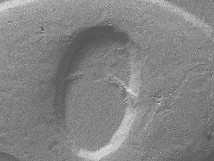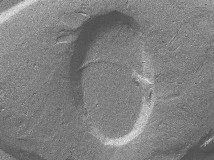Infopages
1888/7 analysis
1888/7 analysis by Chris Pilliod
The 1888/7 Die #2 Snow -2 is quite a different animal from Die #1. There's a lot going on with this die, and some effort is needed to "separate the wheat from the chaff". In this case, unlike Die #1the date is obviously repunched, notably on the last three 8's. In addition, what is being refered to as a"7" has dramaticly less prominence as compared to Die #1. As a result an SEM (scanning electron microscope) was utilized to generate high-resolution images at relativly extreme magnifications to help interpret the variety. To this end, I was fortunate in obtaining a very high grade AU58 example from my collection which is augmented by its early die state-the earliest I have ever examined. It was undoubtedly one of the first pieces struck by this die.
The first photo from the SEM shows the entire 1888/7 date magnified 18x1888.jpg. Notice the repunching that clearly shows in the upper loop of each"8". This is important as we progress through this analysis. Now let us zoom up the magnificationon the last "8" to 50x1888.1jpg. At this magnification we now can differentiate what is merely a repunched "8" and what is left over for explaination. Thanks to the beauty of the SEM, the arc outside and left of the "8" is readily identifiable as a repunched "8". Furthermore, if one visually expands the arc of this repunching to the inside of the "8", the arced portion emanating at about the 9 o'clock point inside the loop and arcing across is also just a repunched "8".
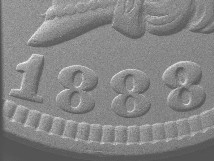
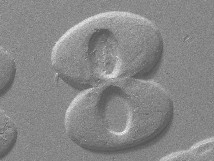
Now the fun begins. The next photo was taken at a whopping 140x and shows just the interior of the upper loop of the last "8"1888.4.jpg. At this magnification, if one strains hard enough, the entire top of an "8" can be seen repunched inside of the loop-the right side of the arc exits the inside of the "8" at approximately 4 o'clock. So what is left to explain is the portion that is not repunched-mainly the vertical bar and the small amount of broad horizontal piece inside the upper loop. Obviously this is not a repunched "8".... so again as with Die#1, what is it??? It has none of the fracture characteristics indicative of a die chip, but has the look more of a rubbed or polished out effect from eradicating a remnant feature.
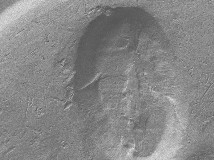
To help us along, a high grade 1887 Indian cent was subjected to the SEM simultaneously for comparison. The first photo shows the entire date of the 1887 (don't bother with the small amount of debris on the coin taken at 18X magnification). The key to the analysis is a comparison of the vertical portion of the "7" taken at exactly the same magnification of 140X, (shown in 1887.1).
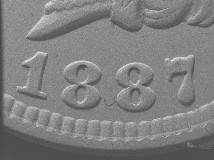
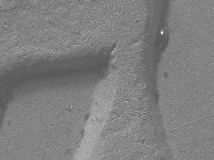
When compared with the photo of the inside of the loop of the 1888/7 taken at 140X, how good of an agreement do we get? Now compare this photo 1887.1.jpg to 1888.doctored.jpg (which is a copy of 1884.4.jpg at 140X )with all portions of what is definitively known to be the remnants of the repunched "8" removed in PhotoShop. So what is left in 1888.doctored.jpg is what we are trying to answer.
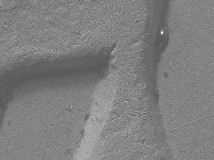
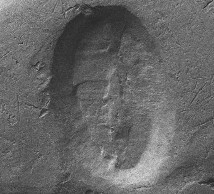
We can't expect perfection if the die was heavily polished, but does it exhibit reasonably similar curvatures. I performed an overlay of the two photos to get a feel for fit. When I overlaid the 1887 against the features inside the uper loop of the last "8" there is clearly similar curvature. The top right corner of the "7" is quite close in a match. How sure am I? Well, I'm not 100% sure, but as an old professor of mine used to say, "I'm not 100% sure the sun will rise tomorrow either", but it is close enough of a match to properly ascribe this as an overdate. About the only other feature it could be would be a die chip, but it has no fracture features.
Having said this, it does not have as abundant of an overdate feature as the Die #1. On the other hand, it carries along a few other anecdotal evidences of an overdate. Namely, there is a nice misplaced digit (visible in front of the first pearl in photo 1888), like the 1858/7 Flying Eagle and the 1887/6 3-cent nickel. Also in chronology, 1888 follows a year fairly abundant with overdates, including the 1887/6 Morgan Dollars so precedent is established.
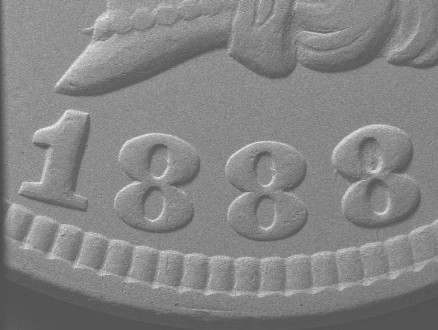
We had a little extra time to burn so we shot the following series of photos at 140X showing each of the repunched 8's of this variety ( 1888.7.jpg is the first "8" and 1888.6.jpg is the second "8"). It is interesting to note that all 8's show nearly identical repunching on the date. This was important as it helped us identify what is repunched and what is not on the last 8. The original date was possibly polished and/or hubbed over as it may have been sunk too deeply and then corrected.
One final note, start having fun looking at your 1889 Indian cents - as I believe there is a possible overdate lurking in this year similar to the Die #2!!!
